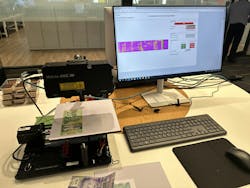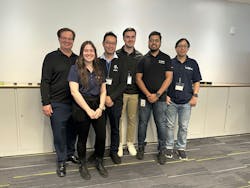Currency Inspection Demonstration Using High-fidelity 3D Profile Sensor
In this video, Valérie Servranckx, an application specialist at Zebra Technologies, demonstrates how currency is inspected using a Zebra AltiZ high-fidelity 3D profile sensor.
“What we’re inspecting here today is our Canadian dollar bills,” said Servranckx. “They all have some tactile features on them so that visually impaired people can recognize the bills just from touch.”
Seeing Beyond Vision Loss
Canadian currency is supported by accessibility features, including large high-contrast numbers and distinct colors. In addition, the Canadian Journey (older notes) and Frontier (with a horizontal orientation) series of banknotes have a tactile feature. A series of raised dots separated by a smooth surface located in the upper left corner of the banknote indicates the denomination.
The raised-dot system uses cells of six dots. The $5 bill has one cell, with the $10, $20 and $50 bills each adding one more cell than the previous. The banknotes were developed with input from Canadians who are blind or partially sighted, as not all users read braille.
“The features (raised dots) have to be about 0.11 mm in height at production,” explained Servranckx. “With this AltiZ model, we can detect 4 to 8 microns in the X-axis. Along the laser line we can do about 30 microns. So, that’s enough in this application.”
A computer display next to the AltiZ showed an image of the features on the $5 bill. “We see that there’s two by three dots, so just one set of those six dots,” explained Servranckx. “The height of the lowest dot in this one is 0.12 mm, which is high enough at production.”
When Servranckx scanned the $20 bill instead, the screen displayed three sets of six dots. “This $20 bill was in circulation a bit more, so the dots were flattened a little bit in these results,” said Servranckx. “We see that they’re a little bit too low. If they were in production, that wouldn’t be accepted.”
High-fidelity 3D Profile Sensor
Machine Design spoke with Valérie Servranckx during a site visit to Zebra Technologies’ Montreal office.
Servranckx was one of several application engineers tasked with demonstrating advanced machine vision solutions to bring attention to Zebra Technologies’ growing portfolio of automation and vision technology. The company’s portfolio spans mobile computing solutions, track-and-trace, software, robotics, machine vision, automation and digital decisioning.
READ MORE: How Zebra Technologies Uses Machine Vision to Transform Production Automation
An AltiZ high-fidelity, high-speed 3D profile sensor is featured in the currency inspection demonstration. It comes in either single camera or dual-camera single-laser designs, which minimize scanning gaps at critical surface junctures. A GigE Vision interface allows users to work directly with a range of vision software, too.
According to Zebra Technologies’ spec sheets, unique algorithms running inside the sensor automatically generate 3D data such as individual profiles, depth maps or point clouds. This is achieved by merging or selecting the pixel data from the two built-in image sensors, which are automatically sampled to maintain a consistent horizontal resolution.
What it Takes to Build a Career in Advanced 3D Imaging
Servranckx, who holds a bachelor or electrical engineering from Polytechnique Montréal, has worked with Zebra Technologies for three years. She was a co-op student at Zebra Technologies during her last year of studies and was offered a full-time position immediately following the internship.
READ MORE: Two Demonstration Machines Address Multiple Medical Device Manufacturing Competencies
One of Servranckx’s long-term goals is to get into development so that she can gain experience creating solutions and figure out how to solve problems. As part of the customer sales team, her role is to provide support and troubleshoot. “Whenever customers have issues with their imaging boards or cameras, or if something is not working with their processing, we help them,” she explained.
Servranckx is bilingual. Her proficiency in both English and French means that she can offer support to Francophone customers in Europe, the region she has been assigned to service. Since she also specializes in 3D applications, she handles those cases, too.
About the Author

Rehana Begg
Editor-in-Chief, Machine Design
As Machine Design’s content lead, Rehana Begg is tasked with elevating the voice of the design and multi-disciplinary engineer in the face of digital transformation and engineering innovation. Begg has more than 24 years of editorial experience and has spent the past decade in the trenches of industrial manufacturing, focusing on new technologies, manufacturing innovation and business. Her B2B career has taken her from corporate boardrooms to plant floors and underground mining stopes, covering everything from automation & IIoT, robotics, mechanical design and additive manufacturing to plant operations, maintenance, reliability and continuous improvement. Begg holds an MBA, a Master of Journalism degree, and a BA (Hons.) in Political Science. She is committed to lifelong learning and feeds her passion for innovation in publishing, transparent science and clear communication by attending relevant conferences and seminars/workshops.
Follow Rehana Begg via the following social media handles:
X: @rehanabegg
LinkedIn: @rehanabegg and @MachineDesign

